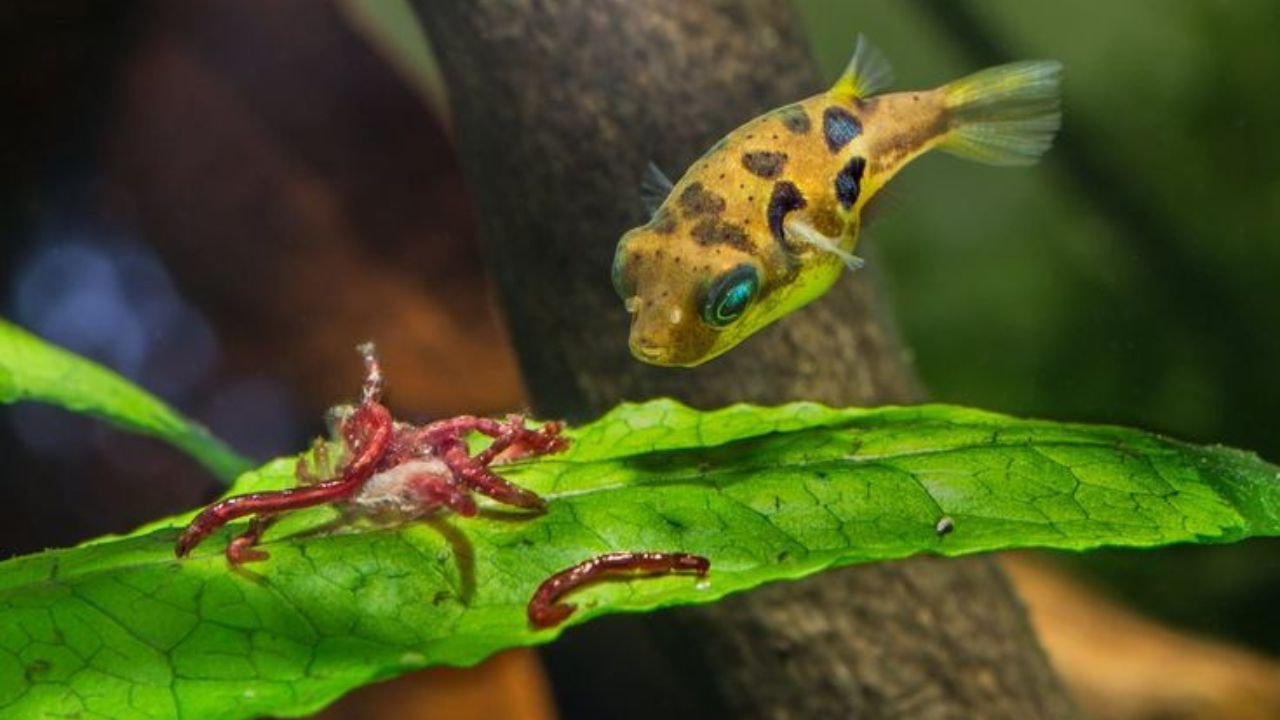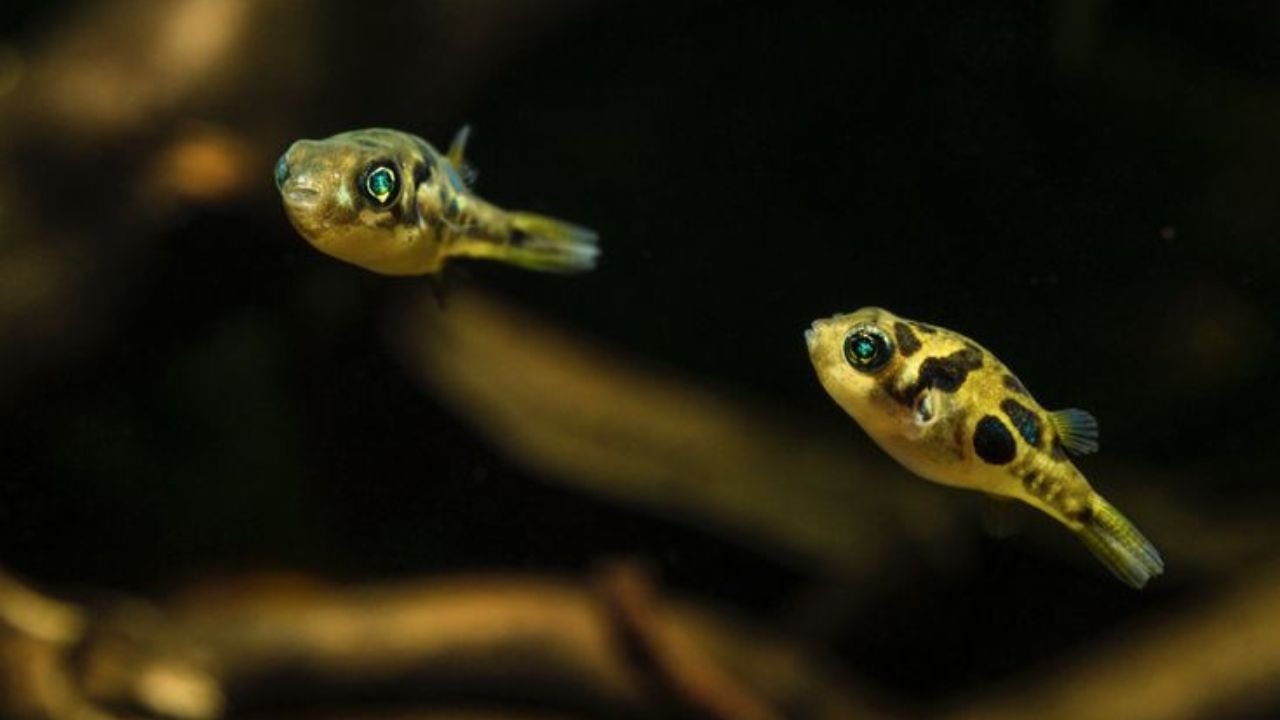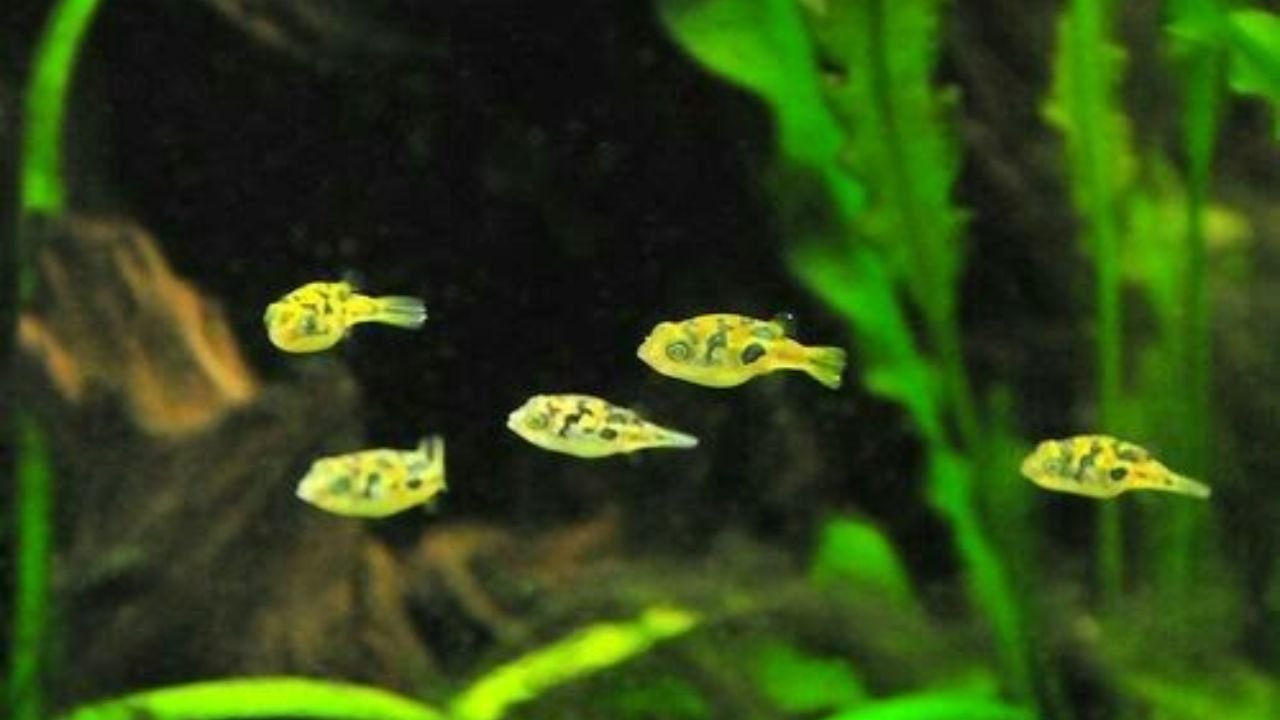Why Dwarf Pufferfish Make Great Aquarium Pets
Do you want a small, fun fish? Meet the Dwarf Pufferfish! People also call them Pea Puffers. Their scientific name is Carinotetraodon travancoricus. They grow to only one inch long, but they are full of charm and fun.
Pea Puffers are great for fish lovers who want something new. They move a lot and love to explore. Their big eyes and bold looks make them easy to love. But they are not like other fish—they need special care and space. They don’t always get along with tank mates.
This guide will help you take care of your Pea Puffer. You’ll learn about tank size, clean water, food, and even tank companions. Want baby puffers? We’ll show you how to breed them too. At the end, we’ll answer common questions so you feel ready.
Dwarf Pufferfish Class
Dwarf Pufferfish are also called Pea Puffers. They are small but very interesting. These fish are part of a big group called ray-finned fish. Most fish in the world are in this group. They all have fins with hard rays.
Pea Puffers belong to the pufferfish family. This is the same group as the puffers in the sea. Even though Pea Puffers live in fresh water, they are close to their ocean cousins. They can puff up when they feel scared.
This puffing makes them look big. It helps keep other fish away. It’s a smart trick for such a small fish!
Pea Puffers may be tiny, but they are part of a big and cool fish family. They are fun, smart, and full of charm.
- Aquarium Safety Guide
- Pearl Gourami Care
- Synodontis Catfish
- Pictus Catfish Care
- Golden Ram Cichlid
- Coral Beauty Angelfish

Dwarf Pufferfish Size vs Pea Dwarf Puffer Size
Dwarf Pufferfish are also called Pea Puffers—they are the same fish. When fully grown, they reach about 1 inch in length. People call them “pea puffers” because they are so small. But don’t be fooled! These tiny fish are bold, active, and love to explore.
Dwarf Pufferfish Size Overview
Fish Type | Average Size |
Dwarf Pufferfish | 1 inch |
Pea Dwarf Puffer | 1 inch |
Pea Dwarf Puffed Up: Why Does It Happen?
Pea Puffers puff up when they feel scared or upset. This helps them look bigger and scare other fish. In a tank, puffing is rare. But if it happens, it means your fish is stressed. Check for problems like aggressive tank mates, dirty water, or sudden changes.
Dwarf Pufferfish Tank Mates
Pea Puffers look cute but can be bossy. They may bite other fish or guard their territory. In small tanks, they often fight. Because of this, most people keep them alone or only with other puffers.
Want to try tank mates? You can, but be careful. Watch how they behave. Some fish may work, like:
- Fast fish – Fish like danios or rasboras can swim away quickly.
- Bottom fish – Fish like kuhli loaches or small catfish stay low and out of the way.
- Snails or shrimp – Some people add these for cleaning, but puffers might eat them.
Every puffer is different. Some like company. Some don’t. Watch your tank and see how they behave.
In the end, keeping them alone might be best. It helps keep your puffer—and other fish—safe and calm.

Compatible vs Incompatible Tank Mates
Compatible Tank Mates | Incompatible Tank Mates |
Fast danios (in large tanks) | Long-finned species like guppies |
Amano Shrimp (with caution) | Small or slow fish |
Kuhli loaches (bottom dwellers) | Betta fish, Gouramis |
Note: Even with “compatible” mates, close monitoring is required.
Caring for a Dwarf Pufferfish
Dwarf Pufferfish require dedicated care to thrive. Here are the key care guidelines:
- Tank Size
- Minimum 5 gallons for a single fish.
- Add 3-5 gallons per additional puffer.
- Overcrowding leads to aggression.
- Water Parameters
- Temperature: 74°F–82°F (23°C–28°C)
- pH: 6.5–7.5
- Ammonia/Nitrite: 0 ppm
- Nitrate: < 20 ppm
- Filtration & Maintenance
- Use sponge filters or gentle filtration.
- Weekly 25–50% water changes.
- Clean substrate to prevent ammonia buildup.
- Aquascaping
- Provide dense plants, caves, and driftwood.
- Use live plants like Java Moss and Anubias for cover.
- Break lines of sight to reduce aggression.
Pea Puffer Lifespan
Pea Puffers are small but can live for 4 to 5 years. With good care, they might live even longer.
Like all pets, how you care for them affects their lifespan. Here are some key things that help your puffer live longer:
Good Food
Pea Puffers need protein-rich foods like bloodworms, brine shrimp, and snails. This keeps them healthy and active.
Clean Water
Pea Puffers are sensitive to bad water. Change the water regularly and use a good filter to keep them happy and healthy.
Low Stress
Stress can shorten a fish’s life. Don’t overcrowd the tank, and avoid sudden changes in the water. Choose peaceful tank mates.
Right Living Setup
Pea Puffers can be territorial. Many do best alone or with just other puffers. If you add tank mates, choose peaceful and fast swimmers.
In short, feed them well, keep their water clean, and keep the tank peaceful. These things can help your Pea Puffer live a long, happy life.
Feeding Dwarf Pufferfish
Dwarf puffers are carnivorous and have tiny beak-like teeth that continue to grow throughout their lives. To prevent overgrowth, they need hard-shelled foods like snails.
Ideal Foods:
- Live or frozen bloodworms
- Live blackworms
- Bladder snails
- Daphnia
- Brine shrimp
Feeding Tip: Offer food 1–2 times per day. Remove uneaten food after 15–20 minutes to avoid water contamination.

Breeding Dwarf Pufferfish
Breeding pea puffers in captivity is challenging but possible under optimal conditions. Here’s what you need to know:
Breeding Setup:
- Separate breeding tank (10–20 gallons)
- Dense live plants (Java moss works best)
- 1 male with 2–3 females
Mating Behavior:
- Males initiate courtship by circling females.
- If the female is receptive, they lay eggs in dense plant cover.
- Adults do not guard the eggs and may even eat them.
Dwarf Pufferfish Eggs
- Eggs hatch in about 5–7 days.
- Fry feed on infusoria initially, then move on to baby brine shrimp.
- Raise fry in a separate tank for survival.
Tip: Keep the breeding tank clean and monitor for fungus on eggs.
Final Thoughts
Dwarf Pufferfish are small but smart fish that can live well if given the right care. They’re not the best choice for beginners. They need special care, space, and a specific diet.
But for dedicated fish keepers, pea puffers are worth the effort.
Whether you love their unique behavior, cute faces, or small size, owning a Dwarf Pufferfish is fun. Just make sure they have a clean tank, good food, and enough space to swim.
FAQ
- How big do dwarf puffers get?
Dwarf puffers grow to about 1 inch (2.5 cm), making them one of the smallest freshwater pufferfish.
- Are dwarf puffer fish friendly?
No, they are territorial and can be aggressive, especially toward other puffers or slow-moving fish.
- Do dwarf puffer fish have teeth?
Yes, they have sharp, beak-like teeth that grow continuously and require a diet of hard-shelled foods to prevent overgrowth.
- Which puffer fish are not poisonous?
Unlike some marine puffers, dwarf puffers are non-toxic and safe to handle, though they should never be ingested.
- Are dwarf pea puffers aggressive?
Yes, they are known for being aggressive, particularly in overcrowded or poorly structured tanks.

